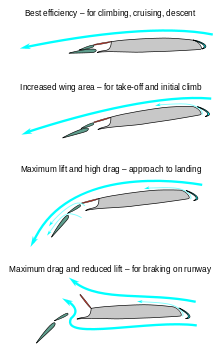Wikijunior Wie Dinge funktionieren/ Flugzeugflügel
Dieser Buchabschnitt benötigt eine Übersetzung ins Deutsche – der fremdsprachige Text ist hier zu finden. Wenn Sie Fragen haben, wie man Texte übersetzt, so schauen Sie in diese Hilfe. Ihre textbezogenen Fragen und Anmerkungen können Sie auf dieser Diskussionsseite besprechen.
Wenn Du an dieser Seite arbeiten möchtest, schenke bitte vorher den Autorenhinweisen kurz Deine Aufmerksamkeit. Danke!
Der Flügel ist der Teil eines Flugzeuges, welches ihm ermöglicht vom Boden abzuheben.
Wer hat ihn erfunden?
[Bearbeiten]Viele Menschen haben versucht, einen Flügel zu erfinden, der es ermöglichte zu fliegen. Sogar der berühmte Erfinder Leonardo da Vinci entwarf Pläne für verschiedene Möglichkeiten, wie ein Vogel zu fliegen. Der erste Flügel, der diesen Traum ermöglichte wurde im alten China im Jahr 559 erfunden. Er sah aus wie ein großer Drachen. 877, lange bevor diese Informationen durch Marco Polo und andere Entdecker nach Europa gebracht wurden, entwickelte ein Arabischer Erfinder in Spanien namens Abbas Ibn Firnas den ersten Hängegleiter und testete ihn selbst.
Sir George Cayley und später auch Otto Lilienthal erschafften funktionierende Hängegleiter, die es den Menschen im 19. Jahrhundert erlaubten zu fliegen. Die Brüder Wilbur und Orville Wright sind durch ihr Flugzeug, das sie zum ersten Mal in Kitty Hawk, North Carolina präsentierten, berühmt geworden. Ihr Flugzeug funktionierte auf dieselbe Art und Weise wie Lilienthals Hängegleiter.
Woher bezieht er die nötige Energie?
[Bearbeiten]Die einzige Energie, die ein Flügel benötigt, ist die Energie, die bei der Forwärtsbewegung des Flugzeuges entsteht. In a glider the wing is either pushed to get it started, or it is brought somewhere high up and dropped, like a hang glider pilot starting from the top of a cliff. In a powered airplane, the engines either push or pull the wings through the air.
The shape and positioning of a wing is very important. Die meisten Flügel sind buckelig geformt, damit die Luft oben schneller vorbeiströmt als unten. Weil das Flugzeug zusammen mit dem Flügel schneller wird, it is more spread out than the air below the wing. Air presses on everything around it, even though you can't feel it. When there is more air it pushes more on the things around it. The fast-moving, spread-out air over the top of the wing lets the air on the bottom of the wing push the wing up, creating lift.
Another way to think of it is that the wing of an airplane is usually tilted so that the front is higher than the back. The air that follows the upper and lower surfaces of the wing is directed downward by the wing's shape and tilt. This creates an opposing upward lifting force on the wing itself. It is the lift from the wings that carries a plane through the air.
Wie gefährlich ist er?
[Bearbeiten]Flugzeugflügel sind nicht gefährlich. Airplanes themselves have a good safety record when they are well maintained and handled. Flügel sind so gefährlich wie jedes schnelle Objekt and so depends also on the material it is made. First planes were made of very flimsy material because of weight and wings strength evolved accordingly to the speed requirements, the faster the plane the stronger the material must be.
Was macht er?
[Bearbeiten]
Ein Flügel ist ein Teil des Flugzeuges, der es in die Höhe hebt. In der Luft wirken hauptsächlich vier Kräfte auf das Flugzeug. Wings provide the force to the airplane that takes it up against the force of gravity due to earth. Ein Flugzeugflügel ist so gebaut, dass Luft, die um ihn herum ist, dazu gebracht wird, dabei zuhelfen, das Flugzeug abheben zu lassen. Er ist auch stromlinienförmig gebaut, sodass das Flugzeug nicht durch die Luft außenherum gebremst wird.
The horizontal 'front' or 'leading edge' splits the air so that the airstream over the top of the wing has to travel further than the airstream beneath the wing. When the two streams meet again at the 'trailing edge' the upper airstream has been stretched and the lower airstream has been compressed. The wing tries to equalize the air pressure above and below by moving up, but of course it can not move upwards without also lifting the airplane!

The reason an airplane is so called is because each wing provides two flat surfaces or planes which are joined by a thick, almost semicircular leading edge, and which meet at the sharp trailing edge. Because they split the air wings are properly called Aero-planes or (mostly in the USA) airplanes. Helicopter blades and propellers also technically possess 'airplanes' but today for most people who are not aviation specialists or 'aerodynamicists' the term simply means the complete 'fixed wing aircraft'
Wing shape can be modified to increase or decrease lift using flaps and ailerons
Wie verändert er sich?
[Bearbeiten]Alle Flugzeugflügel haben Klappen, um Auftrieb und Luftwiderstand zu erhöhen. Manche Flugzeuge, vor allem große Jets, haben Störklappen, um das Flugzeug zusätzlich abzubremsen. Das ist wichtig bei der Landung, wenn der Pilot mit einer sehr geringen Geschwindigkeit landen muss, ohne abzustürzen und um das Flugzeug nach dem Aufsetzen so schnell wie möglich zu verlangsamen.
In größeren Flugzeugen sind meistens Triebwerke an den Tragflächen befestigt.
Wie hat der Flugzeugflügel die Welt verändert?
[Bearbeiten]Ein Flugzeugflügel ist eines der fundamentalsten Dinge, damit ein Flugzeug fliegen kann. Ohne ihn fliegt kein Flugzeug and it has brought planes all over the world.
Welche Ideen und Erfindungen mussten entwickelt werden, um ihn zu erfinden?
[Bearbeiten]The first plane had to be invented before any experimentation with the wing could occur. The earliest wings were simply light framed wooden planks, with no such inbuilt drag or lift functions.
Referenzen
[Bearbeiten]{{en:Wikijunior:How Things Work/Airplane Wing}}
